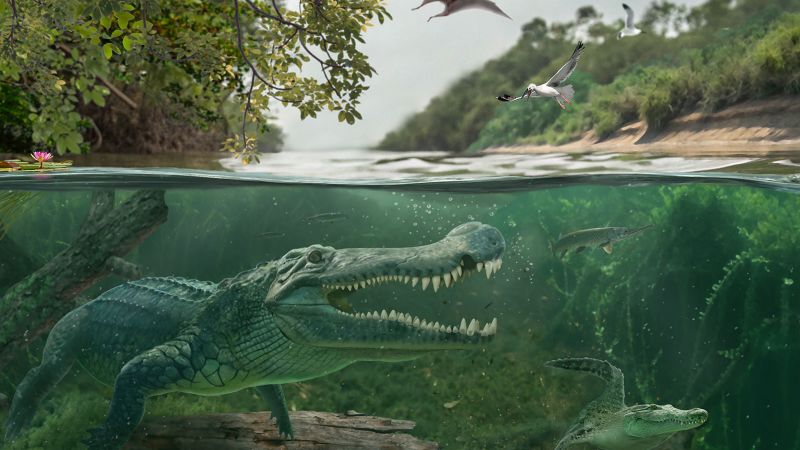In an exploration of prehistoric marine fauna, scientists have uncovered fascinating insights about the significant role of Deinosuchus, a colossal reptile from the Late Cretaceous period. Revered for its broad snout and ferocious appetite, Deinosuchus was a keystone predator that preyed on contemporary dinosaurs. This extinct species, often referred to as the “terror crocodile,” is remarkable not only for its formidable size—comparable to a bus—but also for its uniquely adapted physiology, which distinguished it from modern alligators and crocodiles. Most notably, Deinosuchus possessed saltwater tolerance, a feature that enabled it to thrive in diverse aquatic environments.
Deinosuchus thrived in North America approximately 82 to 75 million years ago, predominantly inhabiting extensive rivers and estuaries. Its skull was of unusual length and width, and bore a distinctive bulbous lump not found in other crocodilians. Evidence gleaned from fossilized Cretaceous bones indicates that this formidable reptile engaged actively in hunting and scavenging dinosaurs. The combination of its massive size and powerful dentition—reminiscent of bananas—suggested it held a dominant position in its ecological niche.
Interestingly, the evolutionary classification of Deinosuchus has changed over time; previously grouped with alligators and their ancient relatives, recent studies indicate that it belongs to a more distinctive branch of the crocodilian family tree. This reassessment arose as paleontologists analyzed both fossil records and genetic data from living crocodilians, including alligators and modern crocodiles. Unlike their modern relatives, which have lost their salt-tolerant glands, Deinosuchus retained these ancestral features, allowing it to inhabit coastal marshes, navigate the vast Western Interior Seaway, and exploit a range of ecological niches while thriving in saline environments.
These findings, recently published in the journal *Communications Biology*, offer significant insights into evolutionary adaptability amidst climatic variations. The ability of Deinosuchus to prowl across the ancient inland sea and inhabit marshy territories helped secure its position as a dominant predator. This adaptability likely provided a competitive advantage, particularly during periods marked by climate change and drastic environmental shifts, as various lineages of crocodilians faced extinction.
Dr. Márton Rabi, a senior author of the study and lecturer at the University of Tübingen in Germany, emphasized the overwhelming size of Deinosuchus, stating it could reach lengths of over 8 meters (26 feet). Fossils of this remarkable reptile have been located on both sides of the ancient seaway, indicative of its wide distribution within prehistoric North America. Notably, while Deinosuchus riograndensis was the largest species known to dwell along the western side of an island called Laramidia, the evolutionary questions surrounding its presence across the seaway lingered until this recent analysis.
Previously, hypotheses related to Deinosuchus either speculated that it was a freshwater exclusive unable to traverse the saline separation or considered that it existed prior to the seaway’s formation. However, the fossil record revealed a contradictory timeline, shedding light on the complexities of its movement and distribution. Additionally, the integration of molecular data provided clarity regarding evolutionary relationships that were previously obscured in crocodilian studies.
Moreover, researchers discovered that the lineage encompassing Deinosuchus diverged from alligators, which have undergone significant evolutionary adaptations. The analysis showcased that salt tolerance was an ancestral trait among various crocodilian species that subsequently diminished in alligatoroids. This trait allowed ancient crocodilian relatives to be opportunistic during environmental upheavals, offering them resilience during episodes of climatic change.
With a redefined understanding and a revised family tree inclusive of previously overlooked fossils, the evolutionary narrative of Deinosuchus evolves into a captivating story of survival and adaptation amidst prehistoric trial. The study not only emphasizes the ecological flexibility of ancient crocodilian species but also outlines the universal tendency of massive body sizes among aquatic reptiles over the last 120 million years, weaving an intricate tale of biodiversity across epochs that persists into the present day. Rabi concluded that giant crocodilians have been the norm rather than the exception, an observation that resonates throughout the history of these fascinating reptiles.












